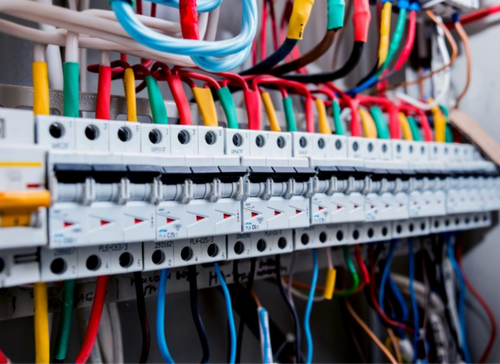Cutting-Edge Technology with BRE Automation Australia Services
Cutting-Edge Technology with BRE Automation Australia Services
Blog Article
The Ultimate Guide to Electrical Installation: Tips and Strategies for a Safe and Reliable Home Wiring System
In the realm of home maintenance, couple of aspects are as important yet often forgotten as the electric circuitry system. Making certain a safe and effective home electrical wiring setup requires not only a fundamental understanding of electrical principles but likewise functional understanding of setup strategies and upkeep methods. From browsing the ins and outs of cord links to fixing usual problems that may occur, this guide intends to outfit house owners with the essential pointers and devices needed for a safe and energy-efficient electrical system. By exploring the subtleties of electrical precaution and energy-saving practices, this extensive overview will certainly drop light on the complexities of home electrical wiring, empowering individuals to organize their home's electrical facilities.
Comprehending Electrical Safety Procedures
To guarantee the safety and security of both individuals and residential property, understanding and executing correct electrical security measures is critical in any kind of home wiring job. It is essential to carry out a comprehensive examination of the electrical system before beginning any kind of wiring task to identify prospective threats or issues that need to be attended to.
Furthermore, utilizing the ideal devices and equipment is necessary for keeping safety during electric installments. Insulated gloves, voltage testers, and protective glasses are several of the basic security gear that must be put on to avoid electrical shocks or mishaps. It is likewise crucial to de-energize circuits prior to functioning on them and to label all circuits and breakers clearly to avoid confusion.

Vital Tools for Home Circuitry
Making certain the appropriate application of electric precaution in home wiring tasks includes utilizing a specific set of crucial tools designed to facilitate the installment procedure efficiently and securely. A few of the key devices required for home circuitry projects consist of a voltage tester for inspecting real-time cables, cord strippers for getting rid of insulation from cables, a cord cutter for exactly reducing cords to length, a screwdriver established for protecting electric components, electric tape for insulation and securing links, a cable ripper for removing wire sheathing, and a multimeter for determining voltage, existing, and resistance. Furthermore, a drill with little bits is important for developing holes for electrical wiring and placing electrical boxes, while fish tapes or poles help in pulling cables via conduits or wall surfaces. It is crucial to purchase high-quality tools to make sure accuracy, efficiency, and security go right here throughout home wiring jobs. By having the essential tools easily offered, homeowners can efficiently browse the installation process and preserve a safe and secure electrical system within their homes - BRE Automation Australia.
Step-by-Step Electric Installation Overview
Beginning an electric setup job requires careful planning and adherence to safety and security guidelines. Before beginning any type of work, ensure you have a detailed plan describing the format of the electric system, consisting of the placement of electrical outlets, switches, and components. Take right into account the power needs of each tool to figure out the appropriate cord scale and breaker sizes.
The very first step in the installation procedure is to shut off the power supply to the area where you will be working. Make use of a voltage tester to confirm that the circuits are de-energized prior to touching any type of wires. Next, thoroughly eliminate existing components or outlets and detach the wires.
When mounting new circuitry, run cables via walls and ceilings, securing them in location with appropriate fittings. Comply with local building ordinance and maker guidelines for proper wire installment and connections. BRE next page Services. See to it to identify wires for very easy identification and future maintenance

Troubleshooting Common Wiring Issues
Having actually finished the setup process as described in the previous subtopic, troubleshooting common electrical wiring issues is an essential ability for making certain the security and performance of your electric system. One usual issue is a tripped circuit breaker, often triggered by overloaded circuits or a short circuit. To fix this, situate the breaker panel, recognize the tripped breaker by looking for the one not completely in the "on" placement, and reset it by turning it fully to "off" and afterwards back to "on." Another common issue is a faulty outlet, identified by no power or periodic power supply. Make certain the electrical outlet is not regulated by a switch, after that make use of a voltage tester to inspect for power. If there is no power, shut off the circuit, inspect the wiring connections for any type of loosened or broken cables, and change the electrical outlet if required. Continuously flickering lights can suggest loosened circuitry links or an overloaded circuit. To address this, check and tighten up all cord links in check my site the influenced fixtures and switches and rearrange the load on the circuit to balance the electrical need. On a regular basis inspecting and without delay addressing these usual electrical wiring concerns will preserve the security and efficiency of your home electrical system.
Tips for Energy-saving Electrical Equipments
For ideal power effectiveness in electric systems, carrying out smart techniques and using energy-saving modern technologies is vital. One key idea for achieving an energy-efficient electrical system is to update to LED lighting. Correct insulation and sealing of home windows, doors, and electric outlets can also stop energy loss, eventually decreasing the work on electrical systems.
Final Thought
Finally, carrying out correct precaution, using essential tools, adhering to a step-by-step installation overview, troubleshooting typical issues, and including energy-efficient ideas are crucial for a risk-free and reliable home electrical wiring system. By sticking to these techniques, homeowners can make certain the longevity and performance of their electric installations. It is essential to prioritize security and performance when it concerns electrical job in order to avoid prospective hazards and to preserve a dependable electric system in the home.
Report this page